임신 제1 삼개월기 태아의 성장 발육, Fetus growrh and develpment during the first trimester of pregnancy
수정의 성립 Fertilization
정자가 난자를 만나면 수정이 된다. 수정된 난자를 수정란이라고 한다. 수정란의 크기는 여기에 있는 마침표의 크기보다도 조금 더 작다. 이렇게 작은 수정란이 자궁 내벽에 착상된 순간부터 약 40주 동안 계속 성장 발육해서 3.4㎏ 정도 되는 만삭아가 된다.
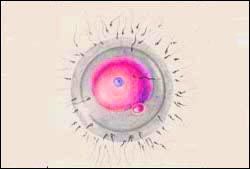
수정된 난자
소스-Pregnancy in Anatomical Illustrations, Carnation Healthcare Services, Los Angeles, CA
임신에서 신생아 돌보기까지(청문각)
![]()
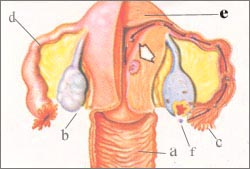
자궁 내벽에 착상된 난자
a-질, b-난소, c-나팔관, d-난관, e-자궁
소스-Pregnancy in Anatomical Illustrations, Carnation Healthcare Services, Los Angeles, CA
임신에서 신생아 돌보기까지(청문각)
![]()
임신이 성립된 순간부터 임신 첫 3개월의 말일까지 기간을 임신 제1 삼개월기(임신 1기/제3 삼분기)라고 한다. 임신 첫 13주 기간을 임신 제1 삼개월기이라고 한다. 임신중 여러 가지 증상과 증후가 임신된 순간부터 임신부에게 나타난다. 참고로
임신이 되면 임신되기 전에 규칙적으로 했던 월경을 더 이상 하지 않는다. 임신 1기 동안 월경을 하지 않는 임신의 증상과 증후 이외 다른 임신 증상이나 증후가 어떤 임신부에게는 거의 나타나지 않는다. 임신 1기 동안에 임신부의 체중이 1,440〜1,920g 정도 늘 수 있고 아기의 중요한 기관의 형태가 형성된다.
임신 제1 삼개월기(제3 삼분기) 동안에 임신부가 가지고 있는 어떤 병을 적절히 치료하지 않거나 임신부가 어떤 종류의 약물을 복용하거나 흡입하든지 주사로 맞든지 바르든지 방사선에 노출되든지 흡연을 하거나 술을 마시면 태아의 건강에 해가 생길 수도 있고 선천성 기형도 생길 수 있고 때로는 유산이 될 수 있다. 또는 임신부가 어떤 종류의 바이러스 감염이나 박테리아 감염 등으로 전염병에 걸리면 그 감염을 일으킨 병원체가 태아에게도 감염될 수 있고 태아의 건강에 해가 생길 수도 있고 선천성 기형도 생길 수 있다.
특히 임신 제1 삼개월기(임신 1기)간 동안 아기의 생명과 건강과 성장 발육에 해가 되지 않도록 임신부는 매사에 극히 조심해야 한다.
임신 제1 삼개월기간 동안에 임신부는 영양분이 많이 있고 균형 잡힌 음식물을 충분히 섭취하고 휴식과 수면을 충분히 취해야 한다. 어떤 종류의 약물이든 의사의 처방이나 지시 없이 임신부 임의로 사용해서도 안 되고 처방한 약도 의사의 지시에 따라 써야 한다.
임신됐다고 진단이 확실히 났을 때는 물론이고, 임신됐다고 의심할 때도 임신중에 꼭 지켜야 할 건강관리를 잘 해야 한다. 산과 전문의나 그 밖의 다른 전문의나 치과의사로부터 진단 치료를 받을 때도 의사나 치과의사가 임신한 것을 모르고 태아에게 해로운 약물이나 방사선을 쓸 수 있다.
이런저런 이유로 의사나 치과의사로부터 진찰 진단 치료를 받기 전에 의사에게 임신했다는 사실을 꼭 알려야 한다.
2주 된 아기(태아)
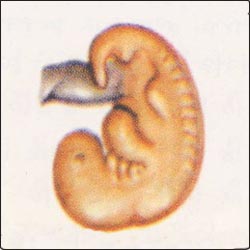
심장이 뛰고 혈액 순환이 시작한다. 척주뼈가 생기고 척수신경이 들어가 있을 관이 척추뼈 속에 생긴다. 눈 코 귀를 확실히 분별할 수 있다. 위장 관이 생기기 시작하고 팔 다리의 형태가 생긴다.
소스-Pregnancy in Anatomical Illustrations, Carnation Healthcare Services, Los Angeles, CA
임신에서 신생아 돌보기까지(청문각)
![]()
임신 4주란 말은 실제로 임신 된지 2주 때이다.
수정된 후부터 임신 첫 8주까지 아기를 배아(Embryo)라 한다.
임신 8주 이후 아기를 태아 라고 한다.
정자와 난자가 결합해서 수정란이 되고 그 수정란은 포배(주머니 배, 胞胚, Blastula )가 된다. 포배 속에 액이 차 있고 수백 개의 세포로 이루어진 일종의 낭이다. 포배는 두 종류의 세포군으로 나누어진다. 그 두 종류의 세포군 중 한 종류의 세포군은 자궁내벽에 부착돼서 태반이 된다.
포배의 바깥층에 있는 세포군들에서 제대, 양수막 난황낭이 생긴다. 포배의 안층에 있는 세포군에서 아기가 생긴다. 아기가 생기는 세포군들은 내배엽, 중배엽, 외배엽의 3층으로 분리된다.
내배엽에서 간, 췌장, 갑상선, 소화기관, 방광 등이 생기고 외배엽에서는 피부, 털, 뇌와 말초신경계가 생기고 중배엽에서는 신장, 혈관, 근육과 뼈 그리고 연골이 형성된다.
2주된 아기의 길이는 0.36~1mm이다.
이런 정보를 다시 공부하면서 많이 느낀 것이 있다. 이런 자세한 정보를 다 알 수 없다. 어떤 내용은 너무도 전문적이다. 그러나 임신한 부부들은 이런 지식까지 알면 임신 분만을 보다 안전하게 할 수 있다.
그런 의미에서 부모가 된다는 것은 여간 어려운 것이 아니다. 여기서 또 “임신부도 적어도 반의사가 되어야 한다”고 말을 또 하고 싶다.
3주된 아기(태아)
임신이 5주됐다고 말 할 수 있다. 그러나 실제로 따지면 아기는 3주가 됐다.
3주된 아기에게 심장 벽이 형성되고 심장이 박동하기 시작한다. 폐도 형성되고 뇌와 척수 등 신경계통이 형성되기 시작한다.
간장, 신장, 근육, 골격 등이 형성된다. 얼굴의 양쪽에 눈과 귀가 생긴다.
수정되어 배아가 되고 배아가 태아로 성장하고 태아가 만삭이 된 아기로 태어날 때까지 태아가 모체의 압력이나 외부의 압력이나 충돌로 손상받지 않도록 양수 속에 항상 잠겨 성장 발육한다.
그 동안 둥글둥글하게 생겼던 배아가 이제 사람의 모양과 같이 길게 생기고 머리와 꼬리 부분이 확연하게 분별할 수 있다.
아기의 길이는 1.25mm이다.
두 개의 동맥과 한 개의 정맥이 탯줄 속에 생겨 있다. 태아가 필요로 하는 각종 영양분과 산소 등이 탯줄에 있는 혈관을 통해서 모체에서 태아에게 공급되고 태아의 배설물이 탯줄을 통해서 태반으로 운반된다.
임신 첫 달 동안에는 임신부의 체중은 눈에 띠지 않을 정도로 점점 조금씩 증가한다. 이 기간 동안 유방이 더 커지고 얼얼하고 입덧이 생길 수 있다.
임신이 됐다는 확실한 진단을 받았었을 때는 물론이고 임신이 됐다고 의심이 될 때도 술, 담배 등 아기에게 해가 될 수 있는 것을 섭취하지 말고 약물은 의사의 지시에 따라서 섭취해야 한다. 담배는 완전히 끊어야 한다.
임신 분만 출산 산후 건강관리를 해줄 산과 전문의를 아직까지 정하지 않고 분만 전 정기 임신검진을 받지 않았으면 산과 전문의를 빨리 정하고 임신검진을 곧 받아야 한다.

4주된 아기의 신장은 2~4mm이고, 5주된 아기의 신장은 4~5mm이고, 6주된 아기의 신장은 1.4~2cm이다(머리끝부터 엉덩이까지 잰 길이). 6주된 아기의 위아래 눈꺼풀은 서로 꼭 붙어 있고 위팔, 팔꿈치, 앞팔과 손, 허벅다리와 무릎, 정강이와 발이 뚜렷이 분별될 수 있다. 탯줄이 발생된다. 뼈, 내장들이 생긴다. 태아에게 달려 있던 꼬리 형태는 더 이상 찾아볼 수 없다
소스-Pregnancy in Anatomical Illustrations, Carnation Healthcare Services, Los Angeles, CA 과 임신에서 신생아 돌보기까지(청문각)
![]()
4주된 아기(태아)의 성장 발육
이 시기의 아기의 성장 발육은 급속도로 진행된다. 등은 활같이 굽어있고 몸 전체의 모양이 올챙이 형태와 같이 생겨 있다.
아직도 꼬리가 등에서 나 있고 뇌부가 더 크고 더 발달했다. 조(스슥, 좁쌀) 알보다 더 작은 크기의 심장이 뛰기 시작한다.
신장, 간장, 척수 등이 계속 점점 더 커지고 더 발달된다. 뇌와 척수가 연결되고 머리의 형태가 사람의 머리 형태와 비슷하게 생긴다. 등뼈, 흉곽강, 복강 등이 형성되고 소화기계 형태가 형성된다.
장차 난소나 고환이 될 형태가 생기고 혈관 심장 순환기가 형성되고 아기의 몸에 혈액이 순환하기 시작한다.
참고로 아기가 8주됐을 때 즉 임신 10주의 아기를 배아라고 하지 않고 태아 (胎兒 Fetus)라고 부른다. 8주 이전의 아기는 배아라고 부른다.
5주된 아기(태아)의 성장 발육
아기의 신장은 4~5mm이다(머리끝부터 엉덩이까지 잰 길이). 5주된 아기의 신체에 주요 기관들이 형성되기 시작한다. 때문에 아기의 건강에 해가 될 수 있는 술, 담배, 약물 등에 노출되지 않게 극히 조심해야 한다.
심장은 좌심장과 우심장으로 나누어지고 1분에 150번 정도 심장이 뛰기 시작한다. 내부 생식기, 위장, 폐, 간장, 신장 등의 형태가 거의 형성된다.
코에 두 콧구멍이 생기고 얼굴에 두 눈이 생기고 입술 혀 등이 생긴다. 장차 이가 날 이싹이 생긴다. 팔다리가 더 길어지고 손발이 될 형태가 생긴다.
이제 제법 사람의 형태를 갖추게 되고 꼬리는 거의 없어진다. 머리는 우둘우둘하고 앞으로 향해서 구부러져 있다.
6주된 아기(태아)의 성장 발육
아기가 6주됐을 때 임신 8주라고 부른다.
6주된 아기의 신장은 1.4~2cm이다(머리끝부터 엉덩이까지 잰 길이).
아기의 얼굴은 사람의 얼굴의 형태와 비슷하게 계속 변화되고 성장 발육된다.
아기의 머리의 크기는 몸통의 크기보다도 훨씬 더 크고 입안에 편도가 형성되고 콧날이 생긴다. 균형 잡는 중추와 청력의 기능을 통제하는 내이가 생기고 아래턱의 형태가 잡힌다.
그 동안 형성됐던 심장, 간장, 폐, 뇌, 신장 등이 더 커지고 발달되고 장관에 제대가 연결된다. 심장은 전주와 같이 1분에 150번 정도 뛰고 피를 펌프해서 아기 자신에게 공급할 수 있다.
피부는 종이두께같이 얇고 피부층을 통해서 피하에 있는 혈관들을 쉽게 들여다 볼 수 있다.
팔다리뼈는 더 길어지고 굵어지고 거기에 관절이 생기고 이제는 아기가 조금씩 운동을 하기 시작한다. 이 때 아주 작은 손가락 발가락이 생긴다.
위, 간, 장 등은 전보다 더 많이 커졌다.
이때 뇌는 다른 기관에 비해서 더 급속도로 성장해서 머리통은 몸통보다 훨씬 더 크다. 머리카락이 난다.
다른 사람들의 눈에 띌 정도로 임신부의 배는 많이 부르지는 않다.
대부분의 임신부들은 전 달보다 더 피로를 느낄 수 있고 소변이 자주 더 마려울 수 있다. 이 달에도 입덧이 계속 될 수 있다.
임신부는 균형 잡힌 음식물을 충분히 섭취하고 휴식과 수면을 충분히 취해야 한다.
7주된 아기(태아)의 성장 발육
머리에서 엉덩이까지 길이는 2.2~3.0cm 된다.
손가락과 발가락이 제대로 형성되고 손가락에 패드가 형성된다.
머리는 앞가슴 쪽으로 꾸부린 형태로 있다.
손 발 다리가 전주보다 커지고 더 잘 발달되어 있다.
두 눈꺼풀로 안구가 덥혀있고 코의 형태가 제법 생겼다.
횡경막이 생기고 복강의 형태가 생기면서 장에 연결된 제대형태가 전주보다 더 뚜렷하다.
8주된 아기(태아)의 성장 발육
8주된 아기를 임신 10주된 아기라고 부르기도 한다. 임신 10주된 아기를 배아(Embryo)라고 부르지 않고 태아(Fetus)라고 부른다. 머리는 아직도 몸통에 비해서 확연히 더 크고 머리에 얼굴 형태가 생기고 그 얼굴의 양쪽에 한 개의 눈이 확연히 생겨있고 얼굴의 한가운데에 확연하게 코가 생겨 있다.
이제 손가락 · 발가락 · 팔목 · 발목 · 팔다리의 관절이 확연히 분별된다.
20개의 젖니가 날 이싹이 있는 잇몸과 턱이 생겨있다.
뇌부는 더 커져있고 뇌의 통제를 받아 신체 기능이 이루어진다.
위 · 장 · 신장 등이 움직이기 시작한다.
심장에 우심실, 우심방, 좌심실, 좌심방이 생기고 1분에 150번 정도 심장이 뛴다.
외부생식기가 형성되나 남녀 외부 생식기 성별을 분별하기가 어렵다.
9주된 태아(태아)의 성장 발육
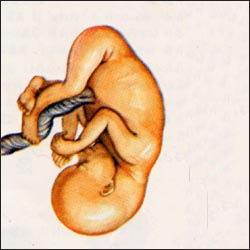
9주 태아의 머리끝부터 엉덩이까지 잰 길이가 4.4~6.0cm이고 체중은 약 8g이다. 팔 다리 손 발 손가락, 발가락이 뚜렷하게 더 자란다. 손톱 발톱 외이도 뚜렷해진다. 턱뼈 속에 유치의 싹이 생긴다. 장차 치아가 날 구멍들이 상악 골과 하악골 속에 생긴다. 안구가 거의 다 발달되고 아래 위 눈꺼풀이 서로 꼭 붙어있다. 특수한 의료기구로 태아의 심장박동을 들을 수 있다.
소스-Pregnancy in Anatomical Illustrations, Carnation Healthcare Services, Los Angeles, CA 와 임신에서 신생아 돌보기까지(청문각)
![]()
태아의 신장은 4.4~6.0cm이고 체중은 약 8g이다. 이제 아기 신체의 거의 모든 기관들의 형태가 형성되어 있다.
0~8주 된 배아에게 바이러스 감염이나 박테리아 감염이 생기든지 배아가 약물, 흡연, 알코올 등 유해물질에 노출되면 선천성 기형이 생길 가능성이 많이 있었다. 그러나 9주 태아에게 그런 위험성은 아직도 있지만 9주 이전과 같이 아주 위험한 시기는 지났다.
태아의 성별을 육안으로 분별할 수 있을 정도로 외부생식기가 생긴다.
손톱과 발톱이 확실히 생긴다. 눈꺼풀로 덥혀 있는 안구에 홍채가 생긴다. 귀도 확연히 생겨있으나 들을 수는 없다.
이때의 태아는 하품도 빨 수도 삼킬 수도 있다. 뇌·위장·간장·신장·폐는 더 완연히 형성되고 발달되면서 기능도 전보다 활발해진다.
손톱, 배안의 털이 생기고 이제부터 그 동안에 형성된 신체의 모든 기관이 점점 더 커지고 발육된다.
태아는 입을 벌렸다 다물 수 있고 손 · 발 · 팔 · 다리 · 머리를 전보다 더 많이 움직일 수 있다.
그렇지만 임신부는 아직도 태아가 움직이는 것을 느낄 수 없다.
임신이 됐을 때의 임신부의 체온은 임신되지 않은 보통 때의 체온보다 좀 더 높고 때로는 미열이 나는 것같이 느낄 수 있다.
임신 제1 삼개월기(임신 1기)는 지나고 임신 제2 삼개월기(임신 2기/제2삼분기 )로 들어간다.
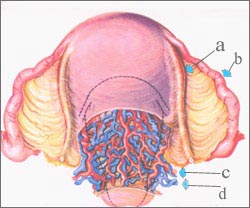
임신 3개월 된 자궁의 전면도
a-원형인대, b-난관, c-동맥, d-정맥
![]()
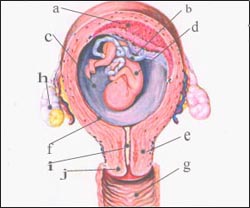
임신 3개월이 된 자궁 종단면
a-태반, b-탯줄, c-양수, d-태아, e-자궁경부, f-양막, g-질, h-난소, i-자궁경관, j-자궁경부
![]()
Fetus growth and development during the first trimester of pregnancy 임신 제1 삼개월기 태아의 성장 발육 Fetus growth and development during the first trimester of pregnancy

Fertilization
When the sperm meets the egg, it is fertilized.
A fertilized egg is called a fertilized egg.
The size of the fertilized egg is slightly smaller than the size of the period here.
From the moment such a small fertilized egg is implanted on the inner wall of the uterus,
it continues to grow and develop for about 40 weeks to become a full term child of about 3.4 kg.
Fertilized egg
Source-Pregnancy in Anatomical Illustrations, Carnation Healthcare Services, Los Angeles, CA
From pregnancy to babysitting (Cheongmungak)

A fertilized egg implanted on the inner wall of the uterus
a-vagina, b-ovaries, c-fallopian tubes, d- infundibulum, e-uterus Source-Pregnancy in Anatomical Illustrations, Carnation Healthcare Services, Los Angeles, CA, From pregnancy to babysitting (Cheongmungak)
- The period from the moment when pregnancy is established to the end of the first 3 months of pregnancy is called the first trimester of pregnancy (first trimester/third trimester of pregnancy).
- The first 13 weeks of pregnancy is called the first trimester.
- During pregnancy, various symptoms and symptoms appear in pregnant women from the moment of conception. Note that When you become pregnant, you no longer have menstruation that you regularly did before you become pregnant.
- During the first trimester of pregnancy, symptoms and symptoms of pregnancy other than those of non-menstrual pregnancy are rarely present in some pregnant women.
- During the first trimester of pregnancy, the weight of a pregnant woman can increase by 1,440-1,920g, and important organs of the baby are formed.
- During the first trimester (third trimester) of pregnancy, any illness that the pregnant woman has is not properly treated, or the pregnant woman is smoking or drinking alcohol, whether it is taking, inhaling, by inhaling, or by injection or applying to radiation, any illnesses she has.
- Drinking can cause harm to the health of the fetus, birth defects, and sometimes miscarriage.
- Or, if a pregnant woman contracts an infectious disease due to some kind of viral infection or bacterial infection, the pathogen that caused the infection can infect the fetus as well, harm the fetus’s health, and cause birth defects. Particularly during the first trimester of pregnancy (the first trimester), pregnant women should be extremely careful about everything so as not to harm the baby’s life, health, and growth.
- During the first trimester of pregnancy, pregnant women should eat plenty of nutrients and well-balanced foods and get enough rest and sleep.
- Any type of medication should not be used by a pregnant woman without a doctor’s prescription or instructions, and the prescribed medication should be used according to the doctor’s instructions.
- You should take good care of your health, which must be observed during pregnancy, as well as when you are sure that you are pregnant, as well as when you suspect that you are pregnant.
- Even when receiving diagnostic treatment from an obstetrician or other specialist or dentist, the doctor or dentist may use drugs or radiation that are harmful to the fetus without knowing that they are pregnant.
- For one reason or another, it is imperative that you inform your doctor that you are pregnant before seeking medical advice from your doctor or dentist.
2 weeks old baby (fetus)

The heartbeats and blood circulation begins.
The spinal column is formed and a tube to contain the spinal nerve is formed in the vertebrae.
Eyes, noses and ears can be clearly identified. The gastrointestinal tract begins to develop and the limbs form. Source-Pregnancy in Anatomical Illustrations, Carnation Healthcare Services, Los Angeles, CA From pregnancy to babysitting (Cheongmungak)
- The term 4 weeks of pregnancy is actually 2 weeks of pregnancy.
- The baby is called an embryo from fertilization to the first 8 weeks of pregnancy.
- Babies after 8 weeks of pregnancy are called fetuses.
- The sperm and the egg combine to become a fertilized egg, and the fertilized egg becomes a blastocyst (pouch belly, 胞胚, blastula).
- The blastocyst is filled with fluid and is a type of sac composed of hundreds of cells. The blastocyst is divided into two types of cell groups.
- One of the two cell groups attaches to the inner wall of the uterus and becomes the placenta. Umbilical umbilical, amniotic yolk sac is formed from cell groups in the outer layer of the blastocyst.
- Babies develop from a group of cells in the inner layer of the blastocyst.
- The cell groups in which babies develop are divided into three layers: endoderm, mesoderm, and ectoderm.
- The liver, pancreas, thyroid gland, digestive organs, bladder, etc. are formed in the endoderm, and skin, hair, brain and peripheral nervous system are formed in the ectoderm, and kidneys, blood vessels, muscles and bones, and cartilage are formed in the mesoderm.
- The two-week-old baby is 0.36 to 1 mm long.
- While studying this information again, I felt a lot. Not all of this detailed information is available. Some of the content is so professional.
- However, pregnant couples can make pregnancy delivery safer if they know this knowledge.
- In that sense, being a parent is not difficult. Here again, I want to say that “pregnant women should at least be anti-doctors.
3-week-old baby (fetus)
- It can be said that the pregnancy is 5 weeks old. But in reality, the baby is 3 weeks old. In a 3-week-old baby, a heart wall forms and the heart begins to beat.
- The lungs are also formed, and the nervous systems such as the brain and spinal cord begin to form. The liver, kidneys, muscles, and skeleton are formed. Eyes and ears appear on both sides of the face.
- It is fertilized to become an embryo, and the embryo grows and develops in the amniotic fluid so that the fetus is not damaged by maternal pressure, external pressure, or collision until the embryo grows into a fetus and the fetus is born into a full-term baby.
- Embryos that had been rounded in the past are now shaped like humans, and the head and tail can be clearly distinguished. The baby’s length is 1.25mm.
- Two arteries and one vein form in the umbilical cord. Various nutrients and oxygen required by the fetus are supplied from the mother to the fetus through blood vessels in the umbilical cord, and fetal excretion is transported to the placenta through the umbilical cord.
During the first month of pregnancy, the weight of the pregnant woman gradually increases to an inconspicuous amount. During this period, the breasts may become larger, tingling, and morning sickness.
When you are convinced that you are pregnant, as well as when you suspect that you are pregnant, do not consume alcohol, cigarettes, or anything that could harm your baby, and take drugs according to your doctor’s instructions.
You should quit smoking completely. Pregnancy Delivery If you have not yet decided on an obstetrician who will take care of your health after childbirth and have not received regular pregnancy checkups before delivery, you should quickly appoint an obstetrician and get a pregnancy checkup soon.

A 4-week-old baby’s height is 2-4mm, a 5-week-old baby’s height is 4-5mm, and a 6-week-old baby’s height is 1.4-2cm (measured from head to hip).
The upper and lower eyelids of a 6-week-old baby are tightly attached to each other, and the upper arms, elbows, forearms and hands, thighs and knees, shins and feet can be clearly distinguished. The umbilical cord develops. Bones and internal organs are formed.
The shape of the tail on the fetus can no longer be found
Source-Pregnancy in Anatomical Illustrations, Carnation Healthcare Services, Los Angeles, CA and From Pregnancy to Newborn Care (Hearing Gak)
Growth and development of a 4-week-old baby (fetus)
- In this period, the baby’s growth and development progress rapidly.
- The back is curved like a bow and the whole body is shaped like a tadpole. The tail is still on the back, and the brain is larger and more developed.
- A heart that is smaller in size than a joe (millet) egg begins to beat.
- The kidneys, liver, and spinal cord continue to grow larger and more developed. The brain and spinal cord are connected, and the shape of the head is similar to that of a human head.
- The spine, thoracic cavity, abdominal cavity, etc. are formed, and the form of the digestive system is formed. In the future, ovaries or testicles are formed, blood vessels and cardiac circulation are formed, and blood begins to circulate in the baby’s body.
- For reference, when a baby is 8 weeks old, that is, 10 weeks of pregnancy, a baby is not called an embryo, but is called a fetus. Babies older than 8 weeks are called embryos.
Growth and development of a 5-week-old baby (fetus)
- The baby’s height is 4-5mm (measured from head to hip).
- The five-week-old baby’s body begins to form major organs.
- Therefore, you must be extremely careful not to be exposed to alcohol, cigarettes, or drugs that may harm your baby’s health. The heart is divided into the left heart and the right heart, and the heart starts beating 150 times per minute. The internal genital organs, stomach, lungs, liver, kidneys, etc. are almost formed.
- There are two nostrils on the nose, two eyes on the face, lips, tongue, etc. In the future, the teeth will sprout. The limbs become longer and the shape of the limbs is formed.
- Now it has a rather human shape and the tail is almost gone. The head is thick and curved forward.
Growth and development of a 6-week-old baby (fetus)
- When a baby is 6 weeks old, it is called 8 weeks of pregnancy.
- A 6-week-old baby is 1.4 to 2 cm tall (measured from head to hip).
- The baby’s face continues to change and grow and develop, similar to the shape of a human face. The size of a baby’s head is much larger than the size of a torso, and a tonsil is formed in the mouth and a nose is formed.
- The inner ear, which controls the central balance and hearing function, is formed, and the lower jaw is shaped. The heart, liver, lungs, brain, and kidneys that have been formed during that time become larger and more developed, and the umbilical cord is connected to the intestine.
- Like before, the heart beats 150 times a minute and pumps blood to supply the baby to himself.
- The skin is as thin as paper and you can easily see the blood vessels under the skin through the skin layer.
- The limb bones become longer and thicker, joints form there, and now the baby begins to exercise little by little.
- At this time, very small finger toes develop.
- The stomach, liver, and intestines were larger than before.
- At this point, the brain grows more rapidly than other organs, so the head is much larger than the trunk. Hair comes out.
- The belly of a pregnant woman is not called as much as others can see.
- Most pregnant women may feel more tired than the previous month and urinate more often.
- Pregnant women should eat enough balanced foods and get enough rest and sleep.
7-week-old baby (fetus) growth and development
- The length from head to hip is 2.2~3.0cm. Fingers and toes are properly formed and pads are formed on the fingers.
- The head is curved toward the prothorax.
- The limbs of the hands are larger and more developed than the previous week.
- The eyeballs are heated with both eyelids, and the shape of the nose is quite formed.
- With the formation of the diaphragm and the shape of the abdominal cavity, the shape of the umbilical cord connected to the intestine is more pronounced than that of the previous week.
Growth and development of an 8-week-old baby (fetus)
- An 8-week-old baby is sometimes referred to as a 10-week-old baby.
- A 10-week-old baby is not called an embryo, but a fetus.
- The head is still significantly larger than the body, and the shape of the face is formed on the head, one eye is clearly formed on both sides of the face, and the nose is clearly formed in the middle of the face. Now the joints of the fingers, toes, wrists, ankles, and limbs are clearly distinguished.
- There are 20 teething gums and jaws with sharp teeth.
- The brain is larger and the body functions under the control of the brain. The stomach, intestines, and kidneys begin to move.
- The heart has the right ventricle, right atrium, left ventricle, and left atrium, and the heart beats 150 times a minute.
- External genitalia are formed, but it is difficult to distinguish between male and female external genitalia.
Growth and development of a 9-week-old fetus (fetus)

- The 9-week-old fetus is 4.4~6.0cm long, measured from head to hip, and weighs about 8g.
- Arms, legs, hands, feet, fingers, and toes are distinctly grown. The nails toenails and the outer ear are also clear.
- In the jawbone, sprouts of the teeth are formed. Holes for future teeth are made in the maxilla and mandible.
- The eyeballs are almost fully developed, and the lower and upper eyelids are tightly attached to each other. You can hear the fetus’s heartbeat with a special medical device.
- Source-Pregnancy in Anatomical Illustrations, Carnation Healthcare Services, Los Angeles, CA and From Pregnancy to Newborn Care
- The height of the fetus is 4.4~6.0cm and the weight is about 8g.
- Almost all the organs of the baby’s body are now shaped.
- Whether viral or bacterial infection occurs in 0-8 week old embryos, or when the embryo is exposed to harmful substances such as drugs, smoking, and alcohol, there is a high possibility of congenital malformations.
- However, although there are still such risks for a 9-week-old fetus, a very dangerous period, such as before 9 weeks, has passed.
- An external genitalia occurs so that the sex of the fetus can be discerned with the naked eye. Nails and toenails are clearly formed.
- An iris is formed in the eyeball that is covered with the eyelid.
- Ears are clearly formed, but they cannot be heard.
- At this time, the fetus may yawn, suck, or swallow.
- As the brain, stomach, liver, kidneys, and lungs are more fully formed and developed, their functions become more active than before.
- The hairs on the nails and stomach are formed, and from now on, all the organs of the body formed during that time are getting bigger and more developed.
- The fetus can open and close his mouth and move his hands, feet, arms, legs, and head more than before.
- However, pregnant women still cannot feel the fetus moving.
- The body temperature of a pregnant woman when she is pregnant is a little higher than her normal body temperature when she is not pregnant and can sometimes feel like she has a mild fever.
- The first trimester of pregnancy (the first trimester of pregnancy) passes, and the second trimester of pregnancy (the second trimester/third trimester of pregnancy) enters.

Front view of the uterus at 3 months of pregnancy
a-circular ligament, b-fallopian tube, c-artery, d-vein

Profile of the uterus at 3 months of pregnancy a-placenta, b-umbilical cord, c-amniotic fluid, d-fetus, e-cervix, f-amniotic membrane, g-vagina, h-ovary, i-cervix, j-cervical
Copyright ⓒ 2014 John Sangwon Lee, MD., FAAP
“부모도 반의사가 되어야 한다”-내용은 여러분들의 의사로부터 얻은 정보와 진료를 대신할 수 없습니다.
“The information contained in this publication should not be used as a substitute for the medical care and advice of your doctor. There may be variations in treatment that your doctor may recommend based on individual facts and circumstances.
“Parental education is the best medicine.“